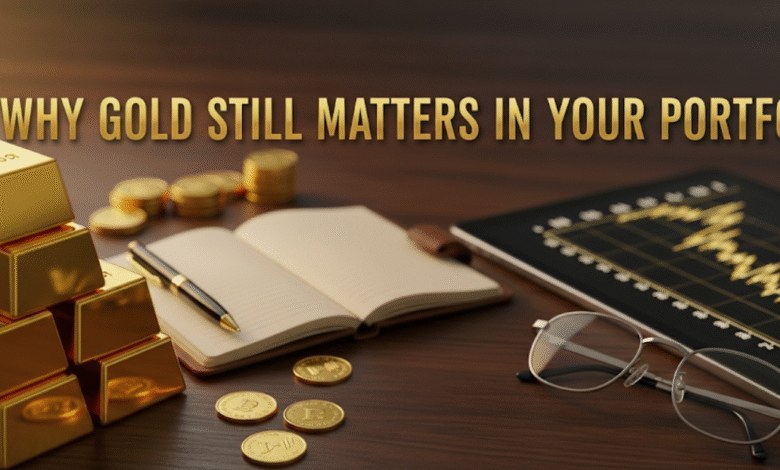
Gold has captivated humans for millennia. From ancient Egyptian pharaohs to today’s throng of investors, the shiny stuff has mesmerized people for thousands of years. But it’s more of a physical element than today’s digital stocks, bonds and cryptocurrencies, leading some people to ask: is gold still worth investing in?
The response is an emphatic yes. Even in an age of technology and with attractive new investment options, gold continues to be one of the best ways to preserve and grow your wealth. This precious metal provides advantages not found with other investments. Whether you are a novice investor or a seasoned pro, gold in your portfolio may be one of the smartest moves you ever make.
In this guide, we’ll look at why gold remains a foundational part of every smart portfolio, as well as how it can help protect your hard-earned money in an emergency, and the best ways to add it to your own investment mix.
The Classic Allure: The Reason Why Gold Stays in Vogue
A Currency That Never Dies
The difference is that paper money, which governments can print in a near-limitless supply, is artificial, gold natural. There’s a limited amount of it on earth, and mining new gold is costly and time-consuming. It’s this rarity that gives gold its enduring value. And when currencies lose purchasing power because of inflation or economic insecurity, gold often remains solid or even rises in value.
Consider the following: you could get a nice suit of clothes for an ounce of gold in 1920, and you can still get one now. The same can’t be said for most paper currencies, which have a tendency to lose value over time.
Global Recognition and Acceptance
Gold is respected throughout the world. It doesn’t matter if you’re in New York, Tokyo or Mumbai — gold holds its value. This universal acceptance makes it a perfect hedge against local economic problems or devaluation.
The Role of Gold as a Portfolio Protector
Inflation Shield
One of the greatest attributes of gold is that it’s a hedge against inflation. In normal times when prices for everyday goods rise, gold prices rise, too. This occurs when investors rush into gold when they watch their paper money lose purchasing power.
| Decade | Average Inflation Rate | Gold Price Performance |
|---|---|---|
| 1970s | 7.4% | +1,365% |
| 1980s | 5.1% | -21% |
| 1990s | 3.0% | -20% |
| 2000s | 2.6% | +315% |
| 2010s | 1.8% | +25% |
Note: Performance history doesn’t imply future performance.
Market Crash Protection
Amid stock market sell-offs, gold often rises. This inverse relationship is what makes gold an ideal insurance policy for your portfolio. The safe haven did its job between 2008 and 2011. While the S&P 500 tumbled by 37%, gold prices surged 5.8%.
Currency Devaluation Defense
Gold can guard against the devaluation of your country’s currency vis-à-vis other currencies. With gold priced in U.S. dollars around the world, it tends to gain when the value of any major currency slips.
Bright Ideas for Your Investment in Gold
Physical Gold: The Traditional Approach
With real gold coins or bars, you have direct ownership of the metal. Popular options include:
Gold Coins: American Gold Eagles, Canadian Gold Maples, South African Krugerrands
Gold Bars: Available in sizes ranging from 1 gram to 1 kilo or more
Jewelry And Ornaments Made Of Gold: Though good looking and tempting, they attract higher charges and are not a good investment option.
Pros: Possession, counterparty risk, physical asset
Cons: Storage, insurance, buy/sell premium
Gold ETFs: Easy and Liquid
It’s very easy to invest in gold without being forced to store the physical metal, through Exchange-Traded Funds (ETFs) that track the metal’s price. Those funds are traded on stock exchanges the way any other stock would be.
Popular gold ETFs are funds that follow the price of gold bullion so they can be readily bought and sold in any brokerage account.
Pros: Highly liquid, low storage costs, easy to trade
Cons: Management fees, no physical ownership
Gold Mining Stocks: Leveraged Exposure
Owning a gold miner can provide enhanced returns as gold prices go up. When gold prices increase, mining company profits often increase even more rapidly.
Pros: Higher return potential, dividend income from some companies
Cons: Specific company risks, subject to more fluctuation than gold itself
Gold Mutual Funds and ETFs
These ETFs invest in a variety of gold investments, such as mining companies, ETFs or physical gold.
Pros: Professional management, diversification within the gold sector
Cons: Higher fees than ETFs, limited control over individual investments
The Ideal Portfolio Balance: How to allocate to gold?
The majority of financial gurus say to keep 5-10% of your portfolio in gold. This percentage offers plenty of protection without too much exposure to any single asset class.
Sample Portfolio Allocations
| Asset Class | Conservative Investor | Moderate Investor | Aggressive Investor |
|---|---|---|---|
| Gold | 10% | 7% | 5% |
| Bonds | 50% | 30% | 15% |
| Stocks | 40% | 63% | 80% |
How you should allocate depends on things like:
- Age and time until retirement
- Risk tolerance
- Economic outlook
- Other investments you own
Gold vs. Other Safe Haven Assets
Gold vs. Treasury Bonds
Gold and government bonds are both safe investments, but operate differently:
Treasury Bonds: Offer reliable income in the form of interest payments, but lose value when inflation is high
Gold: No interest payments, but it tends to appreciate in value during inflation periods
Gold vs. Real Estate
Real estate and gold are both hedges against inflation, but they have their own characteristics:
Real Estate: Generates rental income and tax advantages, but is work-intensive.
Gold: Is highly liquid and easily stored but does not have income profiles
Gold vs. Cryptocurrencies
Though bitcoin is often referred to as “digital gold,” the two assets are very different:
Gold: millennia of being used as a store of value, low volatility
Cryptocurrencies: A new technology with explosive growth potential— but extreme price volatility
Some Mistakes to Avoid When Investing in Gold
Timing the Market
A lot of investors want to buy gold at precisely the right moment and sell at the top. This timing strategy rarely works. Instead, try dollar-cost averaging, which means periodically buying in small amounts over time.
All Eggs in One Basket
Some investors get carried away and put too much of their money into gold. And don’t forget, gold is a portfolio diversifier, not an investment strategy in and of itself.
Ignoring Costs and Taxes
Gold has a cost for its physical form – storage and insurance. ETFs charge management fees. Mining stocks have brokerage costs. Consider these costs when making your trade decisions.
Forgetting About Taxes
Gold investments may result in varying tax treatments:
Collectibles: If you are subject to the collectible tax (28%), holding gold ETF’s longer than a year will be taxed at the collectible rate.
There may be tax consequences in gold ETFs
You are taxed on mining stock similar to ordinary stocks
Speak to tax professional to see if this applies to your situation.
Building Your Gold Investment Plan
Step 1: Evaluate What You Already Have
Look at what you already own. If you have a lot of stocks, gold can be good diversification. If you already have real estate and bonds, you may need less gold.
Step 2: Decide on Your Gold Investment Type
Consider your preferences:
Want to hold physical gold? Start with established coin dealers or precious metals companies.
Prefer convenience? Here’s a closer look at gold ETFs for your existing brokerage account
Interested in growth potential? Look for gold mining companies and funds
Step 3: Start Small But Work Your Way Up
Start out with a modest allocation (say, 2 or 3 percent of your portfolio) and build it up from there. This is a way of learning about how to invest in gold without risking a lot of upfront money.
Step 4: Rebalance Regularly
Check on your gold allocation every six months to make sure it’s within your target range. If your gold has done well and now comprises 15% of your portfolio rather than your target 8%, think about selling some gold and buying investments with those proceeds.
The fundamentals that push or pull gold prices
Interest Rates
Gold becomes more attractive when interest rates are low because gold does not pay interest. Investors do not sacrifice as much opportunity cost by holding non-yielding gold, compared with low-yielding bonds.
Geopolitical Uncertainty
War, political uncertainty and global turmoil frequently push investors towards gold as a safe haven. And current events on the world stage have only solidified this trend.
Dollar Strength
Because gold is priced in U.S. dollars, a stronger dollar generally makes gold more expensive for foreign buyers, which can serve as a drag on demand. Conversely, a weaker dollar can lift gold prices.
Central Bank Policies
As the central banks print money or engage in quantitative easing programs, it can take the value of currencies down with it and see gold become more appealing as an alternative store of value.

Gold Investment Expenses: Everything You Should Know
Physical Gold Costs
- Dealer premiums: 3 to 8 percent above spot price
- Storage costs: $100-$300 a year, for safe deposit boxes
- Insurance: 0.5-1% of value annually
ETF Costs
- Management fees: Typically 0.25-0.40% annually
- Brokerage commissions: $0-10 per trade
Mining Stock Costs
- Standard stock trading fees
- Greater volatility equals possibility of higher loss
FAQs About Gold Investing
Q: Is gold a good investment during a recession?
A: Gold is typically a good investment during a recession, as investors move toward safe haven asset classes. Still, it’s worth noting that the performance of gold varies depending on what precisely instigates each recession. It’s best understood as portfolio insurance, not an assurance of profits.
Q: Should I purchase gold coins or gold bars?
A: Both have advantages. They are easier to sell in small amounts and more recognizable, though generally they may come with higher premium tags. Bars provide lower premiums per ounce but are more difficult to sell in small quantities. And you can decide which is right for you based on your budget and investment goals.
Q: How can I store physical gold safely?
A: Bank safe deposit boxes, home safes, professional storage facilities for precious metal and other options. They all have different costs and levels of security. There should never be a lot of gold sitting at home without security and insurance.
Q: Can my I.R.A. or 401(k) invest in gold?
A: Yes, but with restrictions. Most retirement accounts will allow you to invest in gold ETFs and mining stocks. For physical gold, you’ll require a self-directed IRA with an approved custodian. Regulations are stringent, so speak with a professional adviser.
Q: What is the difference between gold ETFs, and gold mining stocks?
A: Gold ETFs follow the price of gold bullion directly, while mining stocks are shares of companies that actually mine gold. Gold mining stocks. The returns (or losses) of gold mining companies are generally more correlated with movements in gold prices than that of industrial gold users, but carry company-specific factors, along with increased volatility.
Q: What percentage of my portfolio should be in gold?
A: That’s going to depend on if you ask an “expert” or not, but the majority of the experts are going to tell you 5-10% of your total portfolio in gold and precious metals. This is good diversification without concentration fire. Your individual allocation will also depend on your age, risk tolerance and overall investment strategy.
Q: Is gold a good investment now?
A: The point of holding gold is not to earn money through perfect timing. Instead of timing the market, consider dollar-cost averaging, buying regularly over time to smooth out price swings.
Q: Are there any tax benefits to investing in gold?
A: Do investments in gold come with special tax advantages I need to know about? I’m considering gold, and would like to understand how taxes on gains in gold work. Collectibles, which include all physical gold held less than a year, are taxed at the maximum rate of 28%. But the portfolio insurance of gold frequently trumps tax concerns.
Your Golden Opportunity: Steps to the Next You
Gold is a key element to a well-diversified investment portfolio. It remains as relevant today, as it did hundreds of years ago – and with good reason. While you don’t want gold to dominate your holdings, a small amount offers insurance against an uncertain economy and depreciating currency.
The secret to successful gold investing is to begin with well-defined objectives and appropriate risk tolerance. Whether you decide to hold physical bullion, ETFs, miners or some combination, the key is to start forming this important piece of your financial fortress.
Bear in mind that buying gold is an investment for the long run, not a way to make a quick buck. Like any investment, it demands patience, discipline and regular review. Yet for those who take the time to lovingly plan a gold inclusion in your portfolio, it can mean decades of financial security and peace of mind.
While you think about including gold to your investment mix, ensure that you first research your investment options and the associated costs before making any decisions and consult your financial advisor if your investment strategy should include precious metals. Your future self will thank you for getting started today on preserving and diversifying your wealth with this timeless store of value.
